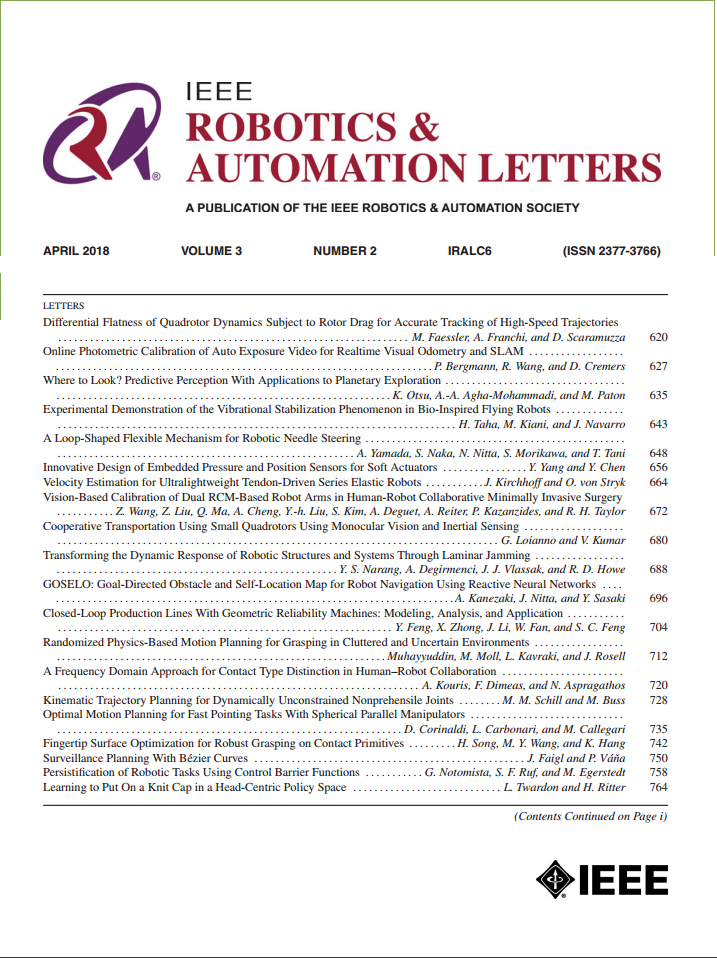RaI-SLAM: Radar-Inertial SLAM for Autonomous Vehicles
IF 4.6
2区 计算机科学
Q2 ROBOTICS
引用次数: 0
Abstract
Simultaneous localization and mapping are essential components for the operation of autonomous vehicles in unknown environments. While localization focuses on estimating the vehicle's pose, mapping captures the surrounding environment to enhance future localization and decision-making. Localization is commonly achieved using external GNSS systems combined with inertial measurement units, LiDARs, and/or cameras. Automotive radars offer an attractive onboard sensing alternative due to their robustness to adverse weather and low lighting conditions, compactness, affordability, and widespread integration into consumer vehicles. However, they output comparably sparse and noisy point clouds that are challenging for pose estimation, easily leading to noisy trajectory estimates. We propose a modular approach that performs radar-inertial SLAM by fully leveraging the characteristics of automotive consumer-vehicle radar sensors. Our system achieves smooth and accurate onboard simultaneous localization and mapping by combining automotive radars with an IMU and exploiting the additional velocity and radar cross-section information provided by radar sensors, without relying on GNSS data. Specifically, radar scan-matching and IMU measurements are first incorporated into a local pose graph for odometry estimation. We then correct the accumulated drift through a global pose graph backend that optimizes detected loop closures. Contrary to existing radar SLAM methods, our graph-based approach is divided into distinct submodules and all components are designed specifically to exploit the characteristics of automotive radar sensors for scan matching and loop closure detection, leading to enhanced system performance. Our method achieves state-of-the-art accuracy on public autonomous driving data.自动驾驶车辆雷达-惯性SLAM
同时定位和绘图是自动驾驶汽车在未知环境中运行的重要组成部分。定位侧重于估计车辆的姿态,而地图捕捉周围环境,以增强未来的定位和决策。定位通常使用外部GNSS系统与惯性测量单元、激光雷达和/或相机相结合来实现。汽车雷达由于其在恶劣天气和低光照条件下的坚固性、紧凑性、可负担性以及广泛集成到消费汽车中,提供了一种有吸引力的车载传感替代方案。然而,它们输出的点云相对稀疏且有噪声,这对姿态估计来说是一个挑战,很容易导致有噪声的轨迹估计。我们提出了一种模块化方法,通过充分利用汽车消费车辆雷达传感器的特性来执行雷达惯性SLAM。我们的系统通过将车载雷达与IMU相结合,利用雷达传感器提供的额外速度和雷达横截面信息,实现了平稳、准确的车载同步定位和地图绘制,而无需依赖GNSS数据。具体来说,雷达扫描匹配和IMU测量首先被合并到局部姿态图中进行里程估计。然后,我们通过优化检测到的循环闭包的全局姿态图后端来纠正累积的漂移。与现有的雷达SLAM方法相反,我们基于图的方法分为不同的子模块,所有组件都是专门设计的,以利用汽车雷达传感器的特征进行扫描匹配和闭环检测,从而提高系统性能。我们的方法在公共自动驾驶数据上达到了最先进的精度。
本文章由计算机程序翻译,如有差异,请以英文原文为准。
求助全文
约1分钟内获得全文
求助全文
来源期刊

IEEE Robotics and Automation Letters
Computer Science-Computer Science Applications
CiteScore
9.60
自引率
15.40%
发文量
1428
期刊介绍:
The scope of this journal is to publish peer-reviewed articles that provide a timely and concise account of innovative research ideas and application results, reporting significant theoretical findings and application case studies in areas of robotics and automation.
 求助内容:
求助内容: 应助结果提醒方式:
应助结果提醒方式:


